Parks Canada research projects
Bears in the mountain national parks
Tracking their every move
Helping bears make good choices
Getting out of the way
Fire, bears and berries
On the fence
Keeping them out
Tracking their every move
Grizzly bear movements through GPS collaring
Parks Canada and Canadian Pacific
Between 2010 and 2015, at any given time, a minimum of 11-13 grizzly bears with GPS radio-collars were being tracked by researchers. The data collected showed where, when and, sometimes, why bears were using the railway.
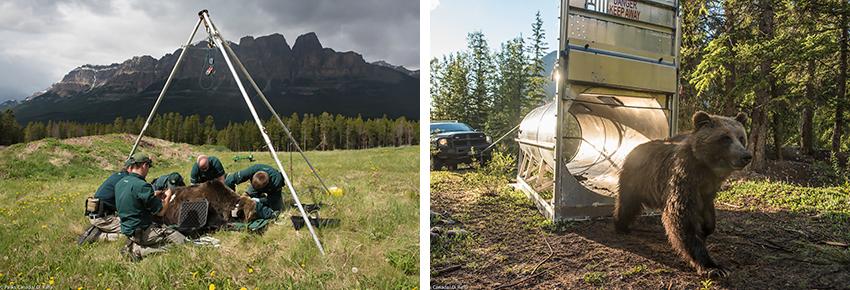
Parks Canada researchers learned how often bears crossed railways and roads. This map shows the movements of bear 122 over one month.

Looking at the data, researchers identified areas of the railway frequented by grizzly bears and zones with the highest risk for train collisions. These results are helping Parks Canada specialists identify where to enhance wildlife trails and how to use prescribed fires and forest thinning to discourage grizzly bears from using high risk areas of the railway.
Did you know?
Grizzly bear cubs in the Canadian Rockies stay with their moms for a relatively long time. On average, female grizzlies spend three years teaching their cubs everything they need to know. Mom will show her cubs how to find the best food at different types of year. She will also teach them to be always on the move to look for their next meal.

Helping bears make good choices
Enhancing wildlife trails to mitigate collision-risk hot spots in transportation corridors, Banff National Park
Ian Pengelly and David Hamer
Researchers studied whether improving travel routes for grizzlies away from the railway would reduce the risk of grizzly bear-train collisions.
Using historical and GPS data, the researchers identified “hot-spots” along the railway where grizzly bears are at an increased risk of a train collision.
Some existing trails near the Town of Banff in Banff National Park that have a high risk for grizzly bear train collisions were enhanced to provide safe alternative travel routes that guided bears away from the tracks. Researchers cleared brush, limbed trees and raked pathways to improve trails through the forest. Then they monitored grizzly bear use of these routes.
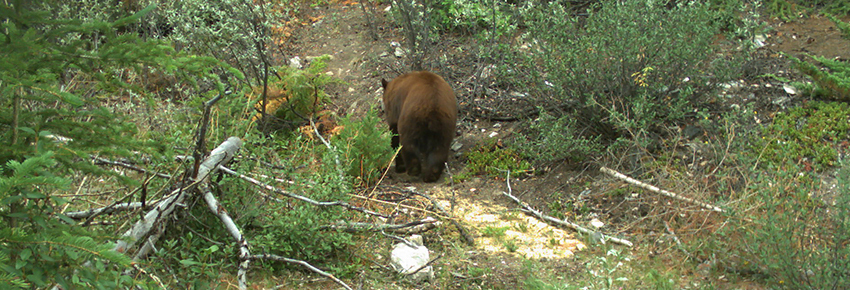
Grizzlies and black bears were both recorded using the enhanced trails. Initial results show promise for this method as a useful mitigation strategy, however more monitoring is needed to see if bears will use the trails consistently. We know grizzly bears keep mental maps of all the trails in their home ranges and travel those trails routinely. It can take years for a bear to adopt a new route in its home range.
Parks Canada is identifying other high risk areas on the railway where alternative travel routes could be established. We will continue to use motion sensor cameras to see if grizzlies adopt the new trails into their home ranges.
Did you know?
Researchers made sure that trails would provide easy travel for many different kinds of wildlife. This included cutting branches on trees to give enough room for a bull elk's antlers to pass. They expect that the smells left behind by other wildlife will encourage grizzly bears to use these trails too.
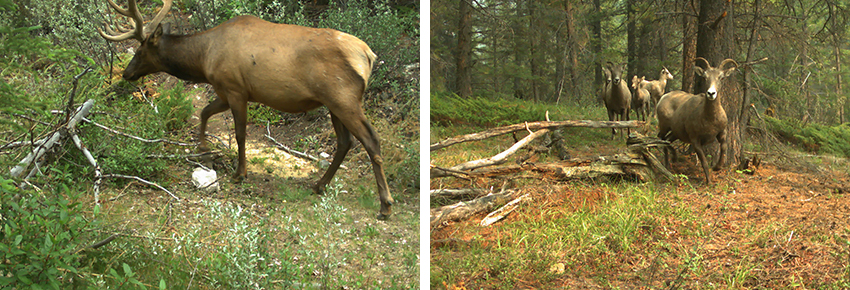
Getting out of the way
Determinants of risk in bear-train interactions
B. Burley, Dr. D. Draper, Dr. R. Cartar, Parks Canada and University of Calgary
Researchers looked at factors affecting the risk of grizzly bear-train collisions using Go-Pro video cameras. Cameras attached to the front of trains recorded bears on the railway and their reactions to trains. Video footage was used to understand what affects a bear’s ability to detect and flee oncoming trains.
They recorded hundreds of hours of footage and learned that a grizzly bear’s reaction to a train isn’t always what you’d expect.
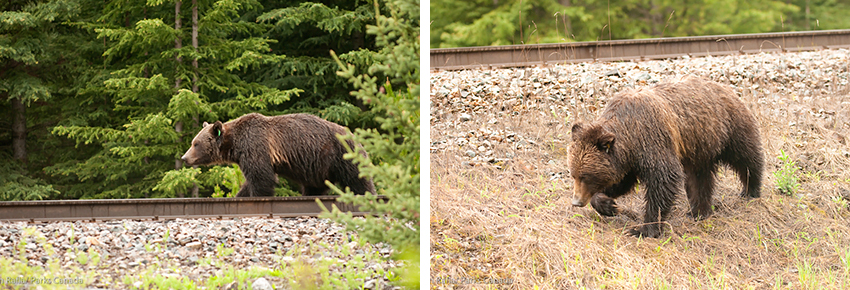
Bears were able to flee trains earlier when the sides of the track were gently sloped. When the track-sides were steeper bears fled the tracks later.
Researchers learned that:
- black bears fled faster than grizzly bears,
- bears escaped sooner when trains travelled at higher speeds,
- bears moved faster when they were further from the tracks when a train approached, and
- bears left the tracks faster when sightlines on the railway were good.
Using this research, areas of the railway in Banff and Yoho national parks were identified that could present a higher risk to grizzly bear-train collisions. Researchers recommend that areas of the railway that had steep embankments and poor sightlines could be the location of targeted measures to reduce risk for bears.
Did you know?
Until the late 1800s, grizzly bears also roamed well across the prairies. They had no lush forests to hide in on the plains, so grizzlies had to stand their ground if challenged. This may explain why some bears choose to defend themselves when surprised by a train.

Fire, bears and berries
Fires, forest thinning, bear foods and bear selection
C. McLellan, J. Park, and Dr. S. Nielsen, Parks Canada and University of Alberta
This project looked at how fire can improve habitat for bears away from the railway.
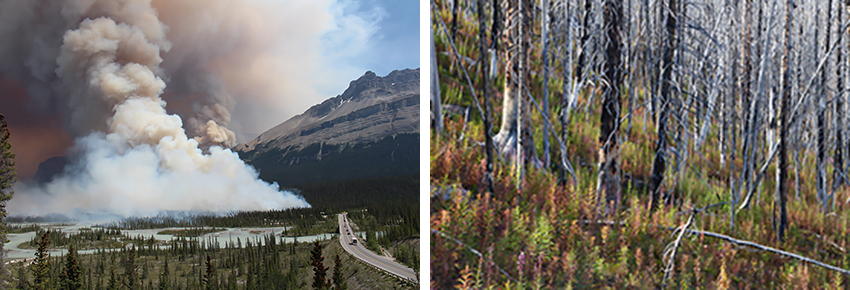
Researchers found that grizzly bears prefer to forage in recently burned habitat over similar but unburned habitat. They also found that critical grizzly bear foods occur more often and are more abundant in burned habitats.
Parks Canada will continue to use prescribed fire to increase important bear foods, like buffaloberry, away from the railway in Banff and Yoho national parks. The recent Sawback prescribed fire and the planned Baker Creek and Dormer Valley prescribed fires will help provide grizzly bear habitat away from the railway.
Did you know?
How much weight a female grizzly bear puts on before winter helps determine whether she will have cubs. A bumper crop of buffaloberries in one summer will likely mean a busy spring for mom the following year!
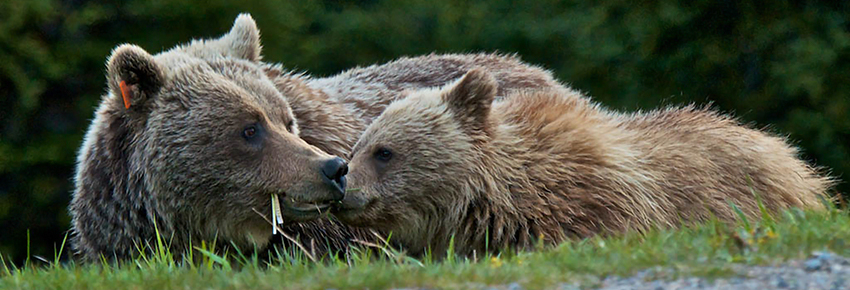
On the fence
A non-electrified fence design for bears
Parks Canada
Researchers looked at ways to stop bears from accessing the train tracks. They tested whether non-electrified fencing could be modified to exclude bears from high risk areas of the railway or highway. To be successful, the fence design must ensure that bears and other large animals are unable to get inside.
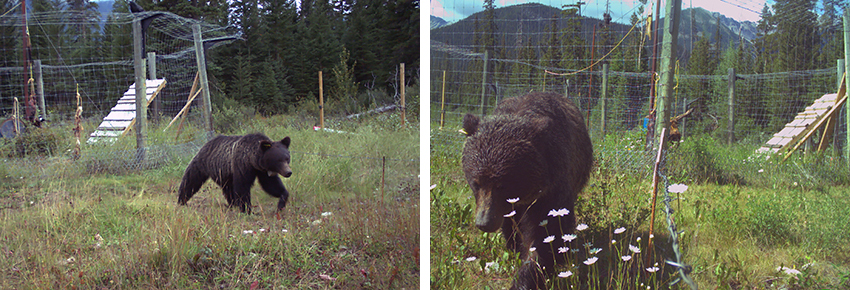
Researchers tested a non-electrified fence design with an outward facing, one metre overhang at a 90 degree angle.
They baited and monitored the non-electrified exclosure with motion-activated still and video cameras. The cameras recorded all animal activity to help analyze interactions with the fence.
Although no bears successfully climbed over the fence, two grizzly bears managed to break-in to the site by pushing and pulling on a weak point in the fence to create a large hole in the wire.
Results suggest that a non-electrified overhang could be used to deter bears from climbing the fence, although more research and testing is required. Researchers recommended that an electrified fence would provide an extra level of prevention--especially important if the bears are strongly motivated by food on the other side of the fence.
Did you know?
In the spring and fall, when bear foods are not as plentiful, grizzlies often need to work hard to find their next meal. Researchers noted that bears spent more time and effort trying to get the bait at times of year when natural foods were not as readily available. In mid-summer when food is easy to find, the bears didn’t try as hard to breach the fence.

Keeping them out
Fence end trials
Parks Canada and Canadian Pacific
Researchers tested whether electrified mats and fences could be used to keep bears and other wildlife off the railway.
Two exclosures (fencing designed to keep animals out) with mock sections of railway were created safely away from the active railway. The exclosures were bordered by electrified mats and fences, had jump outs and wildlife gates, and were baited to encourage wildlife to try to enter.
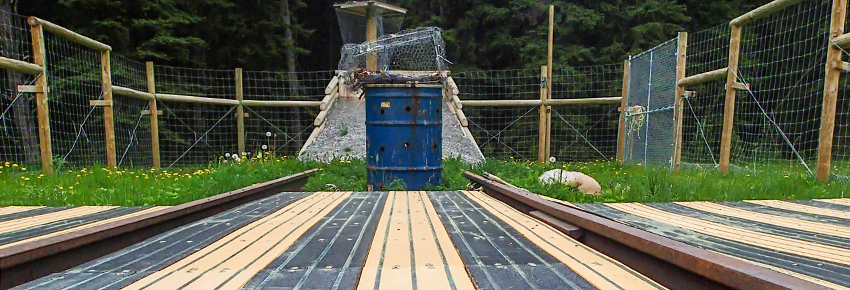
Motion sensor cameras recorded 55 individual attempted crossings by eight different carnivore species. No grizzlies entered the exclosure by crossing the electrified mats when the mats were active.
Electrified mats are experimental and more research is needed. The mats had higher failure rates in winter and have not been tested on ungulates (animals with hooves). Further testing is needed on a railway to assess durability, snow removal and wildlife response.
Parks Canada is continuing to test the electrified mats. The mats, backed up by texas gates, have been installed at several entrances to the highway fencing in Banff and Kootenay national parks.
Did you know?
The electrical current used in these trials is comparable to livestock fencing that would be used on a farm, running between 8000-9000 volts. It causes enough of a shock that wildlife learn to avoid the mats, but is gentle enough that they are not injured.
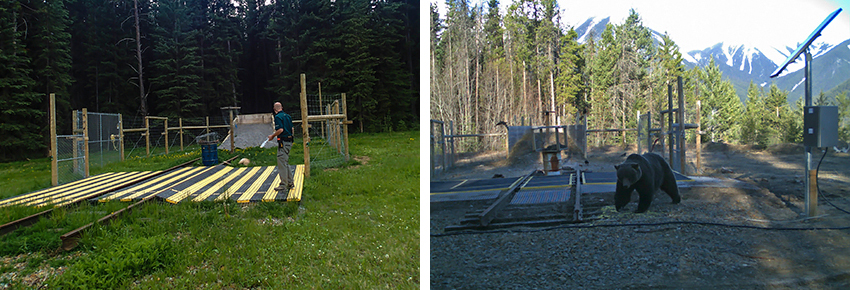
- Date modified :